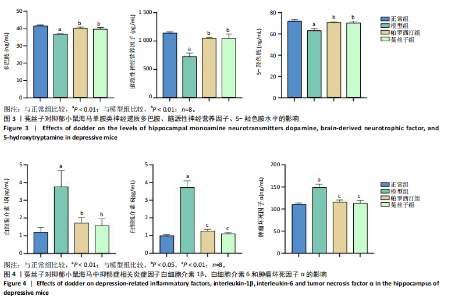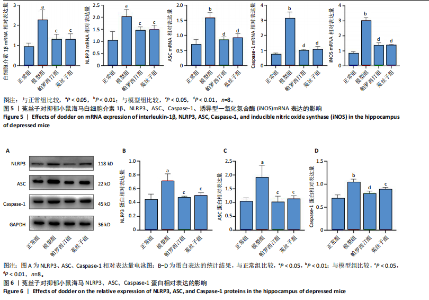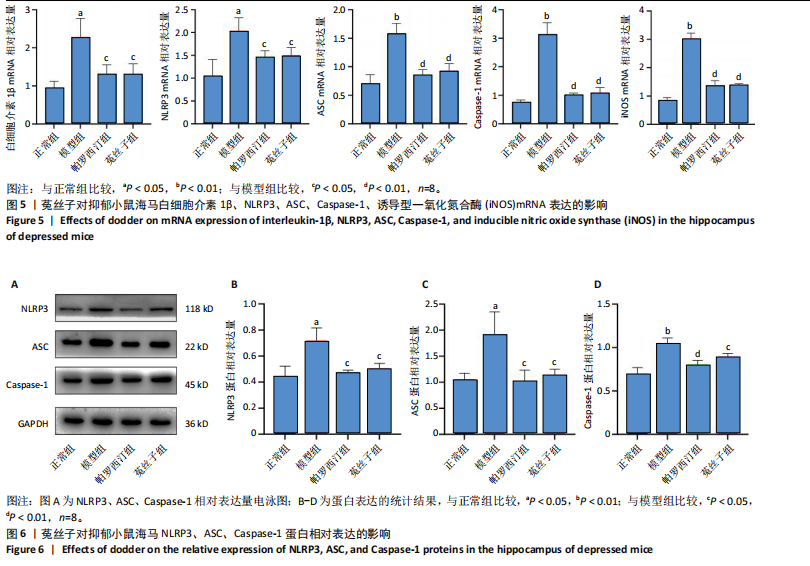Chinese Journal of Tissue Engineering Research ›› 2026, Vol. 30 ›› Issue (10): 2440-2448.doi: 10.12307/2026.636
Previous Articles Next Articles
Dodder intervenes with chronic stress depression in a mouse model: changes in NLRP3 inflammasome
Song Andong1, 2, Fu Huiling3, 4, Yuan Bo1, Li Guohua1, Jia Xusheng2, Jia Menghui2, 3
- 1College of Traditional Chinese Medicine, 4Second Clinical Medical School, Ningxia Medical University, Yinchuan 750000, Ningxia Hui Autonomous Region, China; 2Key Laboratory of Modernization of Minority Medicine of Ningxia, Ministry of Education, Yinchuan 750000, Ningxia Hui Autonomous Region, China; 3Yinchuan First People’s Hospital, Yinchuan 750000, Ningxia Hui Autonomous Region, China
-
Received:2025-03-21Accepted:2025-07-04Online:2026-04-08Published:2025-08-28 -
Contact:Jia Menghui, Professor, Chief physician, Key Laboratory of Modernization of Minority Medicine of Ningxia, Ministry of Education, Yinchuan 750000, Ningxia Hui Autonomous Region, China; Yinchuan First People’s Hospital, Yinchuan 750000, Ningxia Hui Autonomous Region, China -
About author:Song Andong, MS candidate, College of Traditional Chinese Medicine, Ningxia Medical University, Yinchuan 750000, Ningxia Hui Autonomous Region, China; Key Laboratory of Modernization of Minority Medicine of Ningxia, Ministry of Education, Yinchuan 750000, Ningxia Hui Autonomous Region, China -
Supported by:Ningxia Natural Science Foundation, No. 2023AAC03868 (to FHL)
CLC Number:
Cite this article
Song Andong, , Fu Huiling, , Yuan Bo, Li Guohua, Jia Xusheng, Jia Menghui . Dodder intervenes with chronic stress depression in a mouse model: changes in NLRP3 inflammasome[J]. Chinese Journal of Tissue Engineering Research, 2026, 30(10): 2440-2448.
share this article
Add to citation manager EndNote|Reference Manager|ProCite|BibTeX|RefWorks
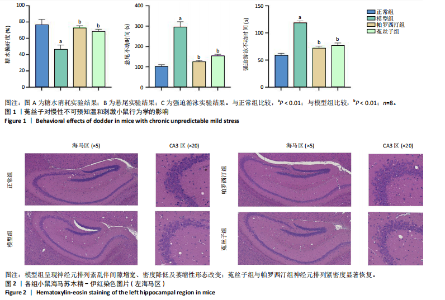
2.1 实验动物数量分析 共60只小鼠,除正常组15只外,其余45只经造模后存活41只,每组14只或13只。 2.2 小鼠行为学变化 见图1。 2.2.1 糖水偏好率 相较于正常组,模型组小鼠糖水偏好率显著下降(P < 0.01);经帕罗西汀或菟丝子干预后,2组小鼠糖水偏好率较模型组均呈现明显回升趋势(P < 0.01);帕罗西汀组和菟丝子组小鼠糖水偏好比较差异无显著性意义(P > 0.05)。 2.2.2 悬尾挣扎时间 相较于正常组,模型组小鼠悬尾挣扎时间显著缩短(P < 0.01);而帕罗西汀及菟丝子干预后,2组小鼠悬尾挣扎时间较模型组小鼠显著延长(P < 0.01),提示药物可改善小鼠抑郁样行为;帕罗西汀组和菟丝子组小鼠悬尾不动时间比较差异无显著性意义(P > 0.05)。 2.2.3 强迫游泳实验 在强迫游泳实验中,模型组小鼠不动时间较正常组小鼠显著延长(P < 0.01);而帕罗西汀及菟丝子干预后,小鼠不动时间较模型组均明显缩短(P < 0.01),提示药物具有抗小鼠抑郁效应;帕罗西汀组和菟丝子组小鼠强迫游泳不动时间比较差异无显著性意义(P > 0.05)。 2.3 菟丝子对抑郁小鼠海马组织病理损伤的影响 苏木精-伊红染色结果显示见图2。正常组小鼠海马CA3区神经元结构致密、排列规则;模型组则呈现神经元排列紊乱伴间隙增宽、密度降低及萎缩性形态改变;而菟丝子组与帕罗西汀组神经元排列紧密度显著恢复,细胞形态学损伤比例下降,提示二者可减轻CUMS诱导的海马神经元结构损伤。 2.4 菟丝子对抑郁小鼠神经递质变化的影响 单胺类神经递质水平下调与抑郁症发病密切相关。如图3所示,模型组小鼠海马组织中多巴胺、5-羟色胺及脑源性神经营养因子表达量均较正常组显著降低(P < 0.01);而帕罗西汀和菟丝子干预可逆转上述指标的下调趋势,其水平较模型组显著升高(P < 0.01),提示二者可能通过调节单胺递质系统发挥抗抑郁作用;帕罗西汀组和菟丝子组神经递质质量浓度比较差异无显著性意义(P > 0.05)。 2.5 菟丝子对抑郁小鼠相关炎症因子的影响 近年研究证实,神经炎症反应是抑郁症发病的核心机制之一[7]。基于此,此次研究采用ELISA法检测海马关键促炎因子水平,见图4。模型组白细胞介素1β、白细胞介素6及肿瘤坏死因子α质量浓度较正常组显著上调(P < 0.05-0.01),而菟丝子与帕罗西汀干预可有效拮抗CUMS诱导的炎症因子过表达(P < 0.05-0.01 vs.模型组),提示其抗抑郁机制可能与抑制神经炎症相关;帕罗西汀组和菟丝子组的几种炎症因子质量浓度比较差异无显著性意义(P > 0.05)。 2.6 菟丝子对抑郁小鼠海马白细胞介素1β、NLRP3、ASC、Caspase-1、诱导型一氧化氮合酶mRNA表达的影响 NLRP1炎症小体作为神经炎症调控的关键分子复合体,其激活可驱动下游促炎因子级联释放[20]。此次研究通过RT-PCR检测发现,模型组小鼠海马组织中NLRP1通路相关分子(NLRP3、ASC、Caspase-1)及炎症标志物(白细胞介素1β、iNOS)表达水平较正常组显著上调(P < 0.05-0.01);而帕罗西汀与菟丝子干预可有效抑制上述因子的异常激活,其表达量较模型组明显下调(P < 0.05-0.01),提示二者可能通过阻断NLRP1炎症小体信号通路减轻CUMS诱导的神经炎症损伤;帕罗西汀组和菟丝子组的几种炎症因子水平比较差异无显著性意义(P > 0.05),见图5。 2.7 菟丝子对抑郁小鼠海马NLRP1、ASC 和caspase-1蛋白相对表达的影响 NLRP1炎症小体作为神经炎症级联反应的核心调控单元,其活化可触发下游炎症因子释放[20]。基于此,研究通过Western blot检测小鼠海马NLRP1炎症小体活化状态,见图6。模型组海马组织中NLRP1、ASC及Caspase-1蛋白表达量较正常组显著上调(P < 0.05-0.01),提示CUMS可通过激活NLRP1炎症小体驱动神经炎症进程;而帕罗西汀与菟丝子干预可有效拮抗CUMS诱导的NLRP1通路蛋白过表达,上述指标较模型组显著下调(P < 0.05-0.01),提示其抗小鼠抑郁机制可能与抑制NLRP1炎症小体活化相关;帕罗西汀组和菟丝子组的几种炎症因子的表达比较差异无显著性意义(P > 0.05),表明菟丝子能抑制NLRP1炎症小体的激活。"
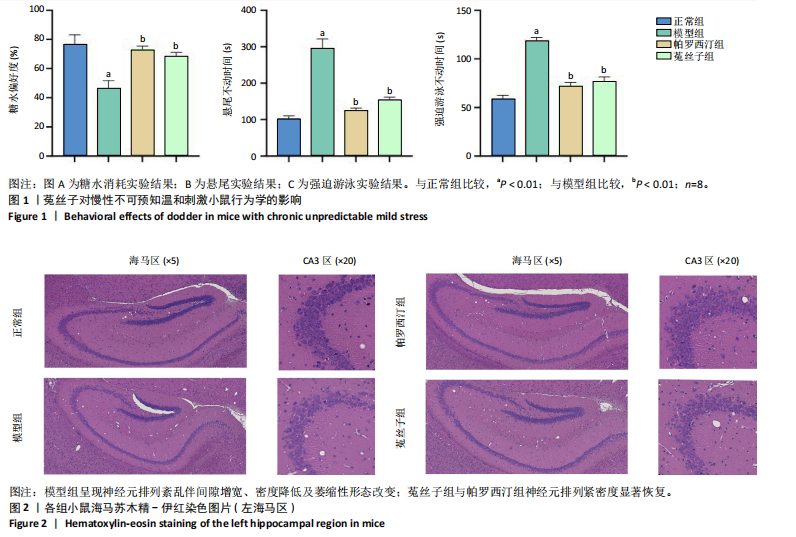
| [1] PENNINX WB, LAMERS F, JANSEN R, et al.Immuno-metabolic depression: from concept to implementation.Lancet Reg Health Eur. 2024;48:101166. [2] 王怡瑾,张雁绚,齐丽,等.基于CiteSpace分析有氧运动干预抑郁的研究现状与发展趋势[J].循证护理,2024,10(17):3174-3180. [3] 杨婷,汪敬轩,谢志豪,等.中国老年居民抑郁症状现状及其影响因素分析[J].现代预防医学,2021,48(19):3461-3465+3599. [4] 宋太医局. 太平惠民和剂局方[M]. 北京: 中国中医药出版社,2020. [5] 林大栋. 扶阳之祖:大宋窦材与《扁鹊心书》[M]. 北京: 中国中医药出版社,2021. [6] 姚广大.菟丝子中抗抑郁有效成分发现及其作用机制研究[D].银川:宁夏医科大学,2022. [7] 王莹,张婧如,田伟,等.菟丝子及其提取物药理机制研究进展[J].中国中医基础医学杂志,2023,29(11):1961-1964. [8] ZHOU L, YANG C, LIU Z, et al. Neuroprotective effect of the traditional decoction Tian-Si-Yin against Alzheimer’s disease via suppression of neuroinflammation. J Ethnopharmacol. 2024;321:117569. [9] HARSANYI S, KUPCOVA I, DANISOVIC L, et al. Selected Biomarkers of Depression: What Are the Effects of Cytokines and Inflammation? Int J Mol Sci. 2022;24(1):578. [10] KOUBA BR, DE ARAUJO BORBA L, BORGES DE SOUZA P, et al. Role of Inflammatory Mechanisms in Major Depressive Disorder: From Etiology to Potential Pharmacological Targets. Cells. 2024;13(5):423. [11] WU A, ZHANG J.Neuroinflammation, memory, and depression: new approaches to hippocampal neurogenesis. J Neuroinflammation. 2023;20(1):283. [12] MA X, SHIN JW, CHO JH, et al. IL-6 expression-suppressing Lactobacillus reuteri strains alleviate gut microbiota-induced anxiety and depression in mice. Lett Appl Microbiol. 2024;77(1):ovad144. [13] YE T, TAO WY, CHEN XY, et al. Mechanisms of NLRP3 inflammasome activation and the development of peptide inhibitors. Cytokine Growth Factor Rev. 2023;74:1-13. [14] DU L, FAN X, YANG Y, et al. Quercetin Ameliorates Cognitive Impairment in Depression by Targeting HSP90 to Inhibit NLRP3 Inflammasome Activation. Mol Neurobiol. 2024;61(9):6628-6641. [15] CHEN H, MA Y, CHEN M, et al. Safflower extract improves depression in mice by inhibiting the TLR4-NLRP3 inflammation signaling pathway. Ann Palliat Med. 2021;10(7):8015-8023. [16] XIA J, CHEN M, SHAO H, et al. Inflammation and Late-Life Depression: Unraveling the Complex Relationship and Potential Therapeutic Strategies. Front Biosci (Landmark Ed). 2023;28(12):356. [17] FU J, WU H. Structural Mechanisms of NLRP3 Inflammasome Assembly and Activation. Annu Rev Immunol. 2023;41:301-316. [18] XIA CY, GUO YX, LIAN WW, et al. The NLRP3 inflammasome in depression: Potential mechanisms and therapies. Pharmacol Res. 2023;187:106625. [19] RAMALINGAM V. NLRP3 inhibitors: Unleashing their therapeutic potential against inflammatory diseases. Biochem Pharmacol. 2023; 218:115915. [20] ZHANG WJ, CHEN SJ, ZHOU SC, et al. Inflammasomes and Fibrosis. Front Immunol. 2021;12:643149. [21] ZHOU JY, SARKAR MK, OKAMURA K, et al. Activation of the NLRP1 inflammasome in human keratinocytes by the dsDNA mimetic poly(dA:dT). Proc Natl Acad Sci U S A. 2023;120(5):e2213777120. [22] LOPES FB, SARANDY MM, NOVAES RD, et al. OxInflammatory Responses in the Wound Healing Process: A Systematic Review. Antioxidants (Basel). 2024;13(7):823. [23] 徐小平,李兴民.实验方剂药理学[M]. 北京:军事医学科学出版社,2020. [24] RATAJCZAK P, MARTYŃSKI J, ZIĘBA JK, et al. Comparative Efficacy of Animal Depression Models and Antidepressant Treatment: A Systematic Review and Meta-Analysis. Pharmaceutics. 2024;16(9):1144. [25] ZHOU Z, WANG Y, SUN S, et al. Paeonia lactiflora Pall. Polysaccharide alleviates depression in CUMS mice by inhibiting the NLRP3/ASC/Caspase-1 signaling pathway and affecting the composition of their intestinal flora. J Ethnopharmacol. 2023;316:116716. [26] ZHANG W, YU M, ZHANG Q, et al. DFO treatment protects against depression-like behaviors and cognitive impairment in CUMS mice. Brain Res Bull. 2022;187:75-84. [27] TROUBAT R, BARONE P, LEMAN S, et al. Neuroinflammation and depression: A review. Eur J Neurosci. 2021;53(1):151-171. [28] GUO B, ZHANG M, HAO W, et al. Neuroinflammation mechanisms of neuromodulation therapies for anxiety and depression. Transl Psychiatry. 2023;13(1):5. [29] 熊庭旺,张珏,石京山.中药抗抑郁作用机制研究进展[J].中医药通报,2024,23(2):65-69. [30] CHEN CY, WANG YF, LEI L, et al. MicroRNA-specific targets for neuronal plasticity, neurotransmitters, neurotrophic factors, and gut microbes in the pathogenesis and therapeutics of depression.Prog Neuropsychopharmacol Biol Psychiatry. 2025;136:111186. [31] (唐)王冰撰注;鲁兆麟主校.黃帝內經素問[M].沈阳:辽宁科学技术出版社,1997. [32] 梁喆盈,雷英菊,金玲.张景岳论治郁证浅析[J].时珍国医国药, 2008,19(2):493-494. [33] 叶橙,孙文军,唐启盛,等. 益肾调气法治疗肾虚肝郁型抑郁障碍远期复发率的多中心前瞻性队列研究[J]. 世界中医药,2024,19(15): 2308-2313. [34] 楼炎灵,李振龙. 定经汤加味联合针灸治疗肾虚肝郁型更年期综合征抑郁症状的临床研究[J]. 中国医药科学,2023,13(5):20-24,32. [35] 罗玉君,肖晓岚,梁敏莉. 肾虚肝郁型绝经综合征患者抑郁与躯体症状的调研[J]. 实用医学杂志,2013,29(11):1861-1863. [36] 宋•唐慎微.宋•寇宗奭衍義,金•張存惠重修.重修政和经史证类备用本草[M].北京:人民卫生出版,1957. [37] 武晓冬. 菟丝子性味功效及临床应用探析[J]. 中国中医基础医学杂志,2023,29(2):280-284. [38] 苏丹,王晓丽,贾孟辉,等.回药阿夫忒蒙丸对失眠大鼠下丘脑5-HT和5-HIAA含量的影响[J].中国民族医药杂志,2016,22(7):54-55. [39] 焦阳,李方,贾孟辉,等.回药阿夫忒蒙丸对80例顽固性失眠患者血浆5-羟色胺水平表达的影响[J].中国民族医药杂志,2015,21(7):5-6. [40] MA J, WANG R, CHEN Y, et al. 5-HT attenuates chronic stress-induced cognitive impairment in mice through intestinal flora disruption. J Neuroinflammation. 2023;20(1):23. [41] GASNIER M, ELLUL P, PLAZE M, et al. A New Look on an Old Issue: Comprehensive Review of Neurotransmitter Studies in Cerebrospinal Fluid of Patients with Schizophrenia and Antipsychotic Effect on Monoamine’s Metabolism. Clin Psychopharmacol Neurosci. 2021;19(3): 395-410. [42] SPENCER NJ, KEATING DJ. Role of 5-HT in the enteric nervous system and enteroendocrine cells. Br J Pharmacol. 2025;182(3):471-483. [43] Tian Y. The Role of Dopamine Neurotransmitters in Neurological Diseases: New Sight. Int J Mol Sci. 2024;25(14):7529. [44] ZELADA MI, GARRIDO V, LIBERONA A, et al. Brain-Derived Neurotrophic Factor (BDNF) as a Predictor of Treatment Response in Major Depressive Disorder (MDD): A Systematic Review. Int J Mol Sci. 2023; 24(19):14810. [45] STEFFEN J, FOCKEN N, ÇALıŞKAN G. Recognizing depression as an inflammatory disease: the search for endotypes. Am J Physiol Cell Physiol. 2024;327(1):C205-C212. [46] DE OLIVEIRA J, KUCHARSKA E, GARCEZ ML, et al. Inflammatory Cascade in Alzheimer’s Disease Pathogenesis: A Review of Experimental Findings. Cells. 2021;10(10):2581. [47] COOMBS JR, ZAMOSHNIKOVA A, HOLLEY CL, et al. NLRP12 interacts with NLRP3 to block the activation of the human NLRP3 inflammasome. Sci Signal. 2024;17(820):eabg8145. [48] GUO ML, ROODSARI SK, CHENG Y, et al. Microglia NLRP3 Inflammasome and Neuroimmune Signaling in Substance Use Disorders. Biomolecules. 2023;13(6):922. [49] ZHANG D, ZHANG Y, PAN J, et al. Degradation of NLRP3 by p62-dependent-autophagy improves cognitive function in Alzheimer’s disease by maintaining the phagocytic function of microglia. CNS Neurosci Ther. 2023;29(10):2826-2842. [50] LI S, FANG Y, ZHANG Y, et al.Microglial NLRP3 inflammasome activates neurotoxic astrocytes in depression-like mice. Cell Rep. 2022;41(4): 111532. [51] LIU X, WANG Y, ZENG Y, et al.Microglia-neuron interactions promote chronic itch via the NLRP3-IL-1β-GRPR axis. Allergy. 2023;78(6):1570-1584. [52] ZHU J, ZHOU F, ZHOU Q, et al.NLRP3 activation in microglia contributes to learning and memory impairment induced by chronic lead exposure in mice. Toxicol Sci. 2023;191(1):179-191. |
| [1] | Haonan Yang, Zhengwei Yuan, Junpeng Xu, Zhiqi Mao, Jianning Zhang. Preliminary study on the mechanisms and efficacy of deep brain stimulation in treating depression [J]. Chinese Journal of Tissue Engineering Research, 2026, 30(在线): 1-9. |
| [2] | Xu Chang, Jiang Mingzhu, Liu Xin, Yan Weijun. Three-dimensional finite element analysis of implant anchorage combined with torque auxiliary arch to lower anterior teeth [J]. Chinese Journal of Tissue Engineering Research, 2026, 30(8): 1971-1978. |
| [3] | Zou Yulian, Chen Chaopei, Huang Haixia, Lan Yuyan, Liu Min, Huang Ting. Resveratrol promotes osteogenic differentiation of bone marrow mesenchymal stem cells in an inflammatory microenvironment [J]. Chinese Journal of Tissue Engineering Research, 2026, 30(7): 1669-1678. |
| [4] | Chen Yulin, He Yingying, Hu Kai, Chen Zhifan, Nie Sha Meng Yanhui, Li Runzhen, Zhang Xiaoduo , Li Yuxi, Tang Yaoping. Effect and mechanism of exosome-like vesicles derived from Trichosanthes kirilowii Maxim. in preventing and treating atherosclerosis [J]. Chinese Journal of Tissue Engineering Research, 2026, 30(7): 1768-1781. |
| [5] | Zhu Kuicheng, Du Chunyan, Zhang Jintao. Mechanism by which hairless gene mutation promotes white adipose tissue browning in hairless mice [J]. Chinese Journal of Tissue Engineering Research, 2026, 30(6): 1424-1430. |
| [6] | Zhang Di, Zhao Jun, Ma Guangyue, Sun Hui, Jiang Rong. Mechanism of depression-like behavior in chronic social defeat stress mice based on high-throughput sequencing [J]. Chinese Journal of Tissue Engineering Research, 2026, 30(5): 1139-1146. |
| [7] | Leng Xiaoxuan, Zhao Yuxin, Liu Xihua. Effects of different neuromodulatory stimulation modalities on non-motor symptoms in Parkinson’s patients: a network meta-analysis [J]. Chinese Journal of Tissue Engineering Research, 2026, 30(5): 1282-1293. |
| [8] | Ma Hong, Ding Xueling, Wang Qi, Lyu Hui, Asya Albusm, Cheng Xinyi, Ma Xiang. Expression and significance of tumor necrosis factor alpha, nuclear factor kappaB and ionized calcium binding adaptor molecule-1 in the hippocampus of mice with aortic dissection [J]. Chinese Journal of Tissue Engineering Research, 2026, 30(4): 858-863. |
| [9] |
Li Tian, Ren Yuhua, Gao Yanping, Su Qiang.
Mechanism of agomelatine alleviating anxiety- and depression-like behaviors in APP/PS1 transgenic mice #br#
#br#
[J]. Chinese Journal of Tissue Engineering Research, 2025, 29(6): 1176-1182.
|
| [10] | Tian Jinxin, Zhao Yuxin, Hu Tong, Cui Tiantian, Ma Lihong. Effects of different transcranial magnetic stimulation modes on refractory depression in adults: a network meta-analysis [J]. Chinese Journal of Tissue Engineering Research, 2025, 29(35): 7639-7648. |
| [11] | Lei Qi, Zhao Bingbing, Luo Hong, Chen Qiang, Jiang Yan. Influenza A virus recombinant hemagglutinin 1 induces the production of beta-defensin and interferon-gamma in mouse tracheal epithelial cells [J]. Chinese Journal of Tissue Engineering Research, 2025, 29(32): 6905-6912. |
| [12] | Deng Qing, Wang Qingjun, Zhang Yeting. Visual analysis of dynamic evolution of research topics in the field of physical activity and hippocampal tissue [J]. Chinese Journal of Tissue Engineering Research, 2025, 29(32): 6997-7003. |
| [13] | Du Juan, Zhang Yi, Hao Quanshui. Effects of exercise on activation of microglia and astrocytes and neuronal apoptosis in depressed rats [J]. Chinese Journal of Tissue Engineering Research, 2025, 29(29): 6243-6248. |
| [14] | Ye Xing, Liu Renyi. Effects of voluntary exercise on molecular expression profiles in the hippocampus of mice: a gene expression profile analysis based on the GEO database [J]. Chinese Journal of Tissue Engineering Research, 2025, 29(24): 5237-5244. |
| [15] | Gao Wenyan, Zheng Zhaoyan, Pan Shang, Wang Peipei, Ji Chunhui, Lyu Shaoping. Bibliometric and visual analysis of Theta burst transcranial magnetic stimulation [J]. Chinese Journal of Tissue Engineering Research, 2025, 29(20): 4389-4400. |
| Viewed | ||||||
|
Full text |
|
|||||
|
Abstract |
|
|||||
